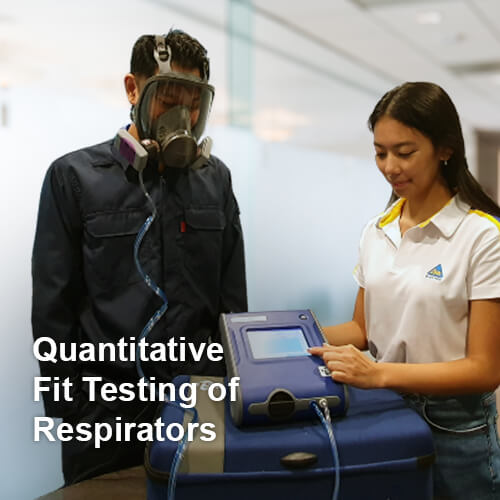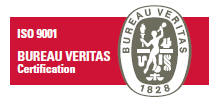
Overview of the Fit Testing Process
Tight-fitting respirators must seal to the wearer’s face in order to provide expected protection. This includes disposable respirators (also called “filtering facepieces”). In Singapore, workers who need to wear respirators at work are required to undergo a medical assessment for fitness to use respirators. Workers with certain medical conditions such as lung problems may not be medically fit to use respirators. Please refer to the Singapore Standard SS 548:2009: Code of Practice for Selection, use and maintenance of respiratory protective devices for additional details.
In addition, fit tests should be performed:
- Whenever a different size, style, model or make of respirator is used.
- When any facial changes occur that could affect fit, such as significant weight fluctuation or dental work.
According to our Singapore Standard SS 548:2009 Code of Practice, it is an essential requirement that Qualitative FIT-testing should only be conducted by the Manufacturer or their Accredited Representatives. Lim Kim Hai Electric is proud to be accredited by 3M Singapore. Our FIT test trainers are trained and qualified for their competency.
Safety Managers are reminded to request for an Authorised letter from the FIT tester’s company before proceeding. Any FIT test conducted by non accredited companies may be subjected to be non compliant to Singapore Standards SS 548:2009.
Qualitative Fit Test (QLFT)
A qualitative fit test (QLFT) may only be used to fit-test:
- Negative-pressure, air-purifying respirators, as long as they’ll only be used in atmospheres where the hazard is at less than 10 times the permissible exposure limit (PEL).
- Tight-fitting facepieces used with powered and atmosphere-supplying respirators.
Each QLFT method uses seven exercises performed for 1 minute each:
- Normal breathing.
- Deep breathing.
- Moving head side to side.
- Moving head up and down.
- Bending over (or jogging in place if the fit test unit doesn’t permit bending at the waist).
- Talking.
- Normal breathing again.
Frequently Asked Question
Why is fit important?
The performance of tight fitting respirators relies on achieving a good seal between the facepiece of the respirator and the wearer’s face. If the seal is inadequate, contaminated air will take the path of least resistance and will travel through leaks in the face seal. Consequently, a poor seal to the face will reduce the level of protection provided to the wearer.
What factors affect fit?
Faces vary widely in shape, size and proportions and it is unlikely that one particular model of respirator will fit everyone. Other factors affecting the seal of a respirator to a wearer’s face include:
- Facial hair – Wearers of tight fitting respirators must be clean shaven in the area of the face seal.
- Eyewear – Both prescription spectacles and safety eyewear affect fit and if worn, should be worn during a fit test.
- Jewellery – Jewellery in the area of the face seal may need to be removed.
Who should be fit tested?
All wearers of tight fitting RPE should receive a fit test on the make(s) and model(s) of respirator that they are required to use. The only exception to this is individuals who are exposed to nuisance levels of substances, i.e. exposure that is genuinely always below the Workplace Exposure Limit and who wear a respirator for comfort only, not for protection. These individuals do not require a fit test.
Who should conduct fit testing?
Fit testing should be conducted by a competent person. To be considered competent a person should have adequate knowledge of fit testing and should have some practical experience. The expected skills and knowledge of a competent fit tester are listed in HSE 282/28.
A fit tester accreditation scheme, “Fit2Fit RPE Fit Test Providers Accreditation Scheme” also exists. This initiative was developed by the British Safety Industry Federation (BSIF) in conjunction with industry stakeholders, including 3M, and is supported by the HSE.
When should fit testing be conducted?
A fit test should ideally be conducted during the initial selection of RPE, before an individual wears the respirator in a hazardous environment. If an untested facepiece is already in use it should be fit tested as soon as possible.
It is good practice to repeat fit testing at regular intervals. This is especially important if RPE is used as the primary means of control e.g. annual testing for workers involved in licensed asbestos removal. In any case fit testing should be repeated if:
- The wearer significantly gains or loses weight, has major dental work or sustains a major facial injury
- A different model or size of RPE is selected
- Specified by company policy
Fit testing is in addition to the requirement to perform a pre-use fit check.
How To Perform Qualitative Fit Testing?
This video will provide instructions on how to perform qualitative fit testing, for half-face filtering facepiece respirators such as 3M Health Care Particulate Respirators and Surgical Masks. Please note the qualitative fit testing instructions for the 3M 1870 Respirator & Surgical mask are the same for other 3M Particulate Respirators.
There are two types of fit test solutions for qualitative fit testing available from 3M:
- A sweet solution as found in the 3M FT-10 Fit Test Kit.
- And a bitter solution as found in the 3M FT-30 Fit Test Kit.
Either of these solutions can be used. However, certain employees may be more sensitive to one solution over the other. During this training, 3M will be demonstrate using the sweet solution. The procedure is the same for the bitter solution.







